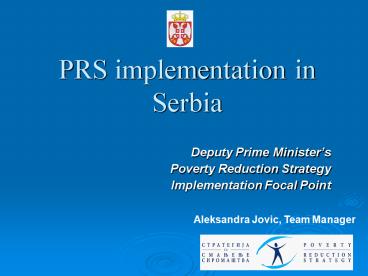PRS implementation in Serbia PowerPoint PPT Presentation
1 / 12
Title: PRS implementation in Serbia
1
PRS implementation in Serbia
- Deputy Prime Ministers
- Poverty Reduction Strategy
- Implementation Focal Point
Aleksandra Jovic, Team Manager
2
Development Framework of Serbia
- Strategy of EU Accession
- Poverty Reduction Strategy for Serbia
- Public Administration Reform Strategy
- Sector strategies
3
Poverty Reduction Strategy
- Multisectoral strategy of socio-economic
development - Complementary goals with EI process and EU Social
Inclusion Agenda - Aligned with UN MDGs MDGs as benchmarks in the
implementation process - Key pillars
- Dynamic economic growth with equity emphasis on
private sector development and job creation - Prevention of new poverty as a consequence of
economic reforms - Maintenance and improvement of social safety net
for the traditionally poor and vulnerable groups
4
PRS Implementation Principles
- Mainstream poverty alleviation into day-to-day
activities and regular programming of all
stakeholders - Ensure linking the PRS with other Serbias
development priorities primarily EI process - Strong emphasis on local level implementation
- Build partnerships to ensure synergy and maintain
national ownership
5
Progress in PRS Implementation- Mainstreaming -
- PRS priorities integrated in plans and budgets -
75 of consolidated expenditures - National Investment Plan based on the PRS
priorities - European Commission MIPD 2007-2013 document
recognizes PRS as complementary with EI. Stresses
EU support for PRS implementation at the local
level - Key international donors support PRS
implementation (EC/EAR, WB, DFID, USAID, NOR,
SIDA)
6
Progress in PRS Implementation- participation
and ownership -
- Parliamentary Forum for PRS implementation
- Civil society Focal Points
- Local level planning and implementation
- 87 municipalities has some kind of the strategic
plan - 65 of the local plans contains PRS
recommendations
7
Progress in PRS Implementation- statistical base
-
- Setting indicators
- Optimization of the existing data and PRS
indicators - Introducing social inclusion indicators
- Data collection RSO capacities improved
- Assumed responsibility for reporting on poverty
statistics using Household Budget Survey as of
2006 - Living Standard Measurement Survey in May 2007
comparable with 2002/2003 - basis for impact
assessment and policy revision process - Reporting
- Annual Report of the GoS
- 2nd Progress Report on the PRS implementation
8
Progress in PRS Implementation- main indicators -
- In 2003, 10.6 of poor (LSMS)
- In 2006, 8.8 of poor (HBS)
9
Challenges in implementing national
strategies/priorities
- Policy directions come from various strategic
documents - Lack of capacity for planning, implementation and
monitoring across Government - Weak link between policies and resources (budget
and international assistance) - Weak central policy coordination
Introduce integrated system of planning,
budgeting, monitoring and reporting Improve the
way GoS work by increasing accountability and
transparency
10
Integrated system of planning, budgeting,
monitoring and reporting
- GOP planning process at the level of line
ministries (17 LMs in 2008) - GOPs as 3-year planning documents reflecting
policy priorities with detailed budget for 1 year - Consolidates national and sector strategies
- Budgeting based on programmatic classification
- Shift focus from input to outcome
- Piloted in 5 Line Ministries in 2007
- Programming of international assistance
- Monitoring and reporting - PRS, MDG and social
inclusion indicators integrated in GOP
11
Key messages for the future
- Strengthen link with EIp stronger focus on
social inclusion - Review impact and update pro-poor policies
- Bring national strategies into one consolidated
national strategic framework - Maintain strong national ownership
- Continue building effective financial planning
and implementation system
12
- Contacts
- Government of Serbia
- Deputy Prime Ministers Poverty Reduction
Strategy Implementation Focal PointAddress
Nemanjina 11/ Room 38 - 11000 Belgrade, Serbia
- Phone 381 11 36 17 590
- prs.ifp_at_sr.gov.yu
- www.prsp.sr.gov.yu

